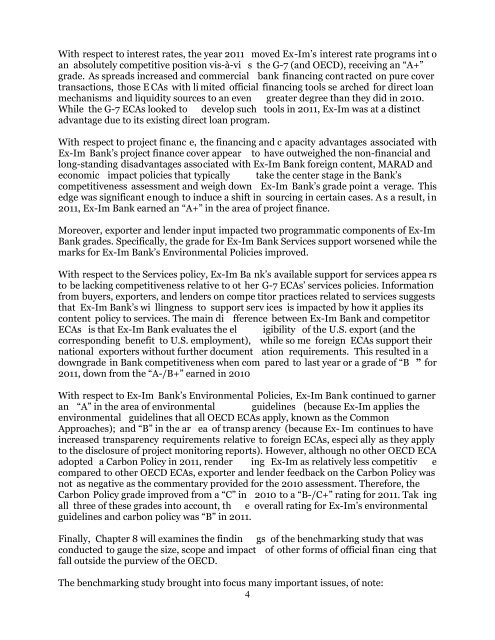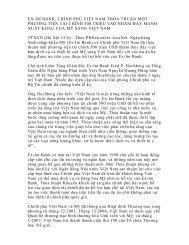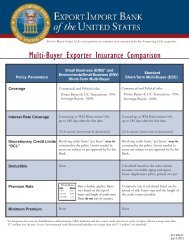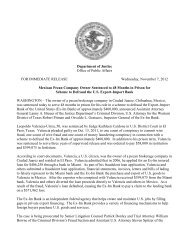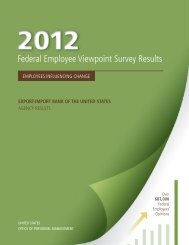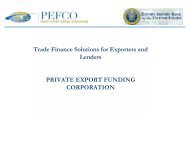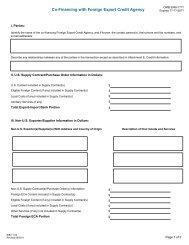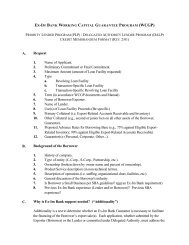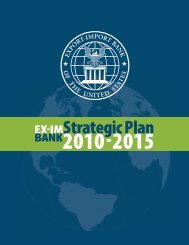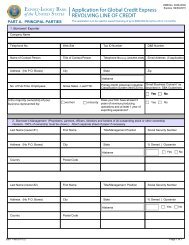2011 508 accessible version - Export-Import Bank of the United States
2011 508 accessible version - Export-Import Bank of the United States
2011 508 accessible version - Export-Import Bank of the United States
- No tags were found...
Create successful ePaper yourself
Turn your PDF publications into a flip-book with our unique Google optimized e-Paper software.
With respect to interest rates, <strong>the</strong> year <strong>2011</strong> moved Ex-Im’s interest rate programs int oan absolutely competitive position vis-à-vi s <strong>the</strong> G-7 (and OECD), receiving an “A+”grade. As spreads increased and commercial bank financing cont racted on pure covertransactions, those E CAs with li mited <strong>of</strong>ficial financing tools se arched for direct loanmechanisms and liquidity sources to an even greater degree than <strong>the</strong>y did in 2010.While <strong>the</strong> G-7 ECAs looked to develop such tools in <strong>2011</strong>, Ex-Im was at a distinctadvantage due to its existing direct loan program.With respect to project financ e, <strong>the</strong> financing and c apacity advantages associated withEx-Im <strong>Bank</strong>’s project finance cover appear to have outweighed <strong>the</strong> non-financial andlong-standing disadvantages associated with Ex-Im <strong>Bank</strong> foreign content, MARAD andeconomic impact policies that typically take <strong>the</strong> center stage in <strong>the</strong> <strong>Bank</strong>’scompetitiveness assessment and weigh down Ex-Im <strong>Bank</strong>’s grade point a verage. Thisedge was significant enough to induce a shift in sourcing in certain cases. A s a result, in<strong>2011</strong>, Ex-Im <strong>Bank</strong> earned an “A+” in <strong>the</strong> area <strong>of</strong> project finance.Moreover, exporter and lender input impacted two programmatic components <strong>of</strong> Ex-Im<strong>Bank</strong> grades. Specifically, <strong>the</strong> grade for Ex-Im <strong>Bank</strong> Services support worsened while <strong>the</strong>marks for Ex-Im <strong>Bank</strong>’s Environmental Policies improved.With respect to <strong>the</strong> Services policy, Ex-Im Ba nk’s available support for services appea rsto be lacking competitiveness relative to ot her G-7 ECAs’ services policies. Informationfrom buyers, exporters, and lenders on compe titor practices related to services suggeststhat Ex-Im <strong>Bank</strong>’s wi llingness to support serv ices is impacted by how it applies itscontent policy to services. The main di fference between Ex-Im <strong>Bank</strong> and competitorECAs is that Ex-Im <strong>Bank</strong> evaluates <strong>the</strong> el igibility <strong>of</strong> <strong>the</strong> U.S. export (and <strong>the</strong>corresponding benefit to U.S. employment), while so me foreign ECAs support <strong>the</strong>irnational exporters without fur<strong>the</strong>r document ation requirements. This resulted in adowngrade in <strong>Bank</strong> competitiveness when com pared to last year or a grade <strong>of</strong> “B ” for<strong>2011</strong>, down from <strong>the</strong> “A-/B+” earned in 2010With respect to Ex-Im <strong>Bank</strong>’s Environmental Policies, Ex-Im <strong>Bank</strong> continued to garneran “A” in <strong>the</strong> area <strong>of</strong> environmental guidelines (because Ex-Im applies <strong>the</strong>environmental guidelines that all OECD ECAs apply, known as <strong>the</strong> CommonApproaches); and “B” in <strong>the</strong> ar ea <strong>of</strong> transp arency (because Ex- Im continues to haveincreased transparency requirements relative to foreign ECAs, especi ally as <strong>the</strong>y applyto <strong>the</strong> disclosure <strong>of</strong> project monitoring reports). However, although no o<strong>the</strong>r OECD ECAadopted a Carbon Policy in <strong>2011</strong>, render ing Ex-Im as relatively less competitiv ecompared to o<strong>the</strong>r OECD ECAs, exporter and lender feedback on <strong>the</strong> Carbon Policy wasnot as negative as <strong>the</strong> commentary provided for <strong>the</strong> 2010 assessment. Therefore, <strong>the</strong>Carbon Policy grade improved from a “C” in 2010 to a “B-/C+” rating for <strong>2011</strong>. Tak ingall three <strong>of</strong> <strong>the</strong>se grades into account, th e overall rating for Ex-Im’s environmentalguidelines and carbon policy was “B” in <strong>2011</strong>.Finally, Chapter 8 will examines <strong>the</strong> findin gs <strong>of</strong> <strong>the</strong> benchmarking study that wasconducted to gauge <strong>the</strong> size, scope and impact <strong>of</strong> o<strong>the</strong>r forms <strong>of</strong> <strong>of</strong>ficial finan cing thatfall outside <strong>the</strong> purview <strong>of</strong> <strong>the</strong> OECD.The benchmarking study brought into focus many important issues, <strong>of</strong> note:4


